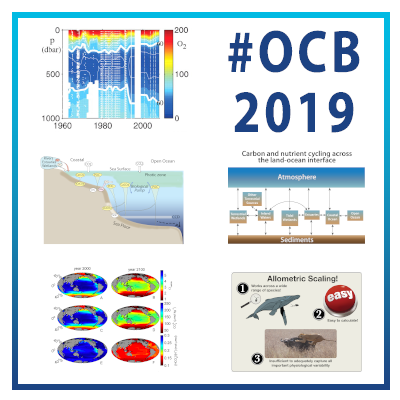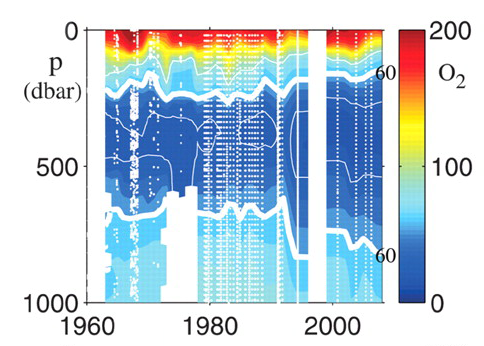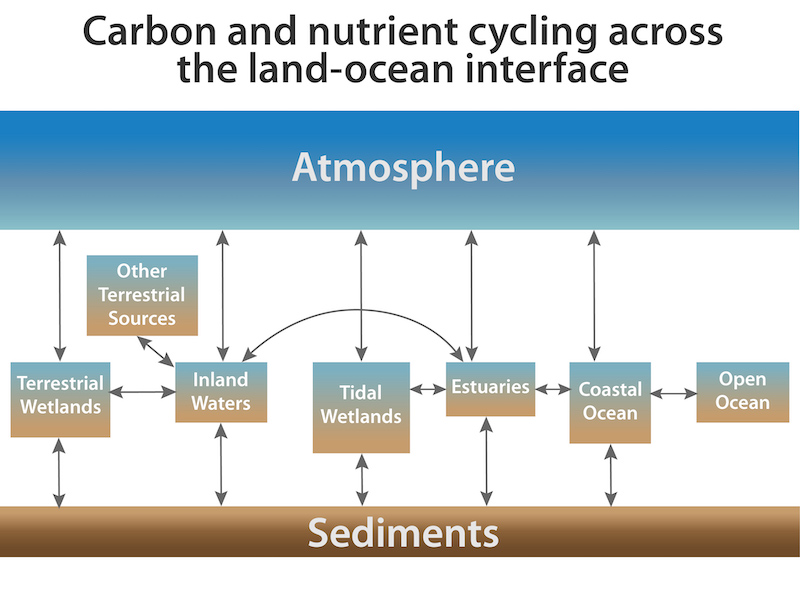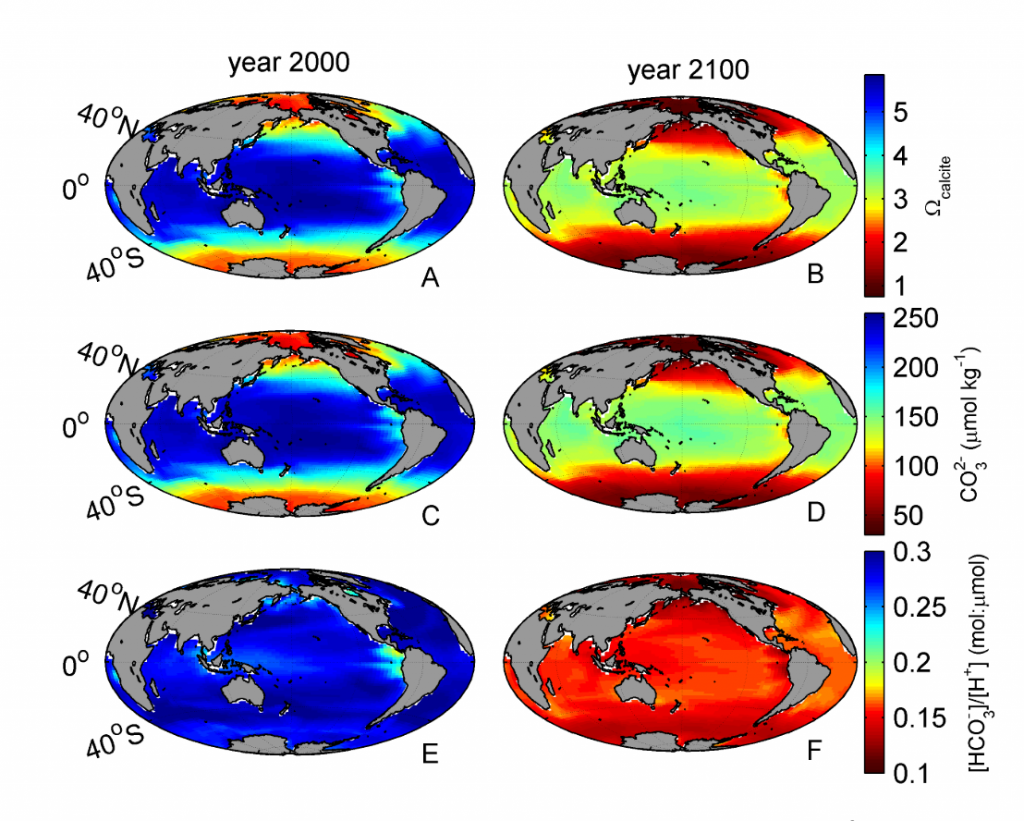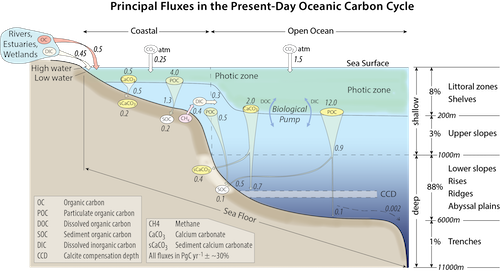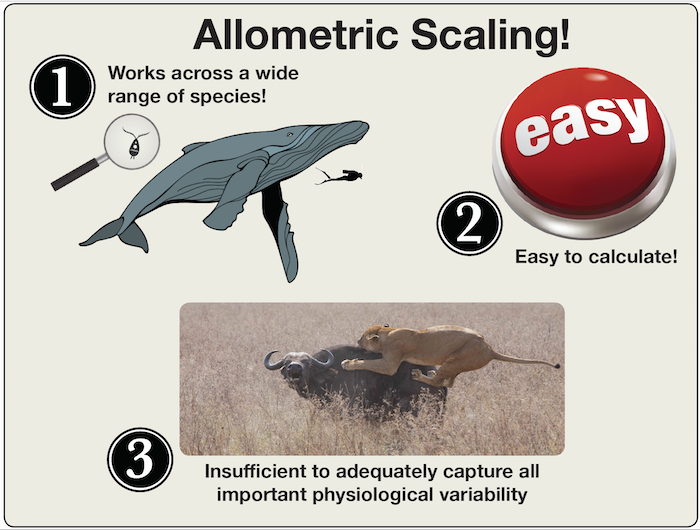Recordings are available via the OCB YouTube Channel - OCB2019 playlist (individual videos and session playlists are linked below in the agenda). Find meeting social media at #OCB2019
Anthropogenic changes in ocean oxygen: Coastal and open ocean perspectives (Monday, June 24)
Chairs: Julie Granger, Adam Martiny, Alyson Santoro, and Ben Twining
Session Description: Warming waters, shifting circulation and ventilation, and coastal eutrophication are driving changes in dissolved oxygen levels in the coastal and open oceans. These changes have impacts on carbon and nutrient biogeochemistry, as well as the health of pelagic and benthic communities. At the same time, naturally occurring seasonal and interannual variability in dissolved oxygen complicates discerning the magnitude and even the sign of long term trends. This session will explore changes in oxygen concentrations observed across a range of environments (coastal to open ocean), while considering a range of physical, biological, and anthropogenic drivers of these changes, as well as their impacts.
Speakers: Andreas Oschlies (GEOMAR), Matthew Long (NCAR), Samantha Siedlecki (Univ. Conn), Malcolm Scully (WHOI), Jerry Tjiputra (UniResearch, Norway), Mariona Claret (U. Washington), Jeremy Testa (UMCES), Marjorie Friedrichs (VIMS)
Calcification and the carbon cycle (Wednesday, June 26)
Chairs: Andrea Fassbender and Jessica Cross
Session Description: 2018 was a year of notable discovery regarding ocean carbonate chemistry, prompting community reflection on important aspects of the marine carbon cycle that are not yet fully understood. One of the major findings relates to changing seasonal cycle amplitudes for carbonate system parameters (e.g., pCO2, [H+], and saturation state) caused by rising ocean temperatures and anthropogenic carbon concentrations. This phenomenon has been anticipated and hypothesized in the literature for over a decade; however, observational evidence at a global scale was just documented for pCO2 in 2018. Complementary modeling work in the last year has also highlighted some of the implications for marine organisms that may be sensitive to pH and calcium carbonate saturation states in both coastal and open ocean regions. In recognition of these findings, this session will consider linkages between ocean chemistry and marine calcification from observational and modeling perspectives. This topic is particularly relevant due to an ongoing discussions in the community regarding which component of the carbonate chemistry (e.g., dissolved inorganic carbon and [H+] vs. saturation state) drives calcification.
Speakers: Andrea Fassbender (MBARI), Lennart Bach (GEOMAR/IMAS Hobart), Bernard Boudreau (Dalhousie), Weifu Guo (WHOI), Kristen Krumhardt (NCAR), George Waldbusser (OSU)
The effect of size on ocean processes (allometry) and implications for export (Thursday, June 27)
Chair: Amy Maas
Session Description: Currently many major models use a suite of allometric relationships to describe and simplify complex interactions in natural systems and predict biogeochemical cycling. This session will describe current effective marine applications of allometry at a range of scales (organismal to ecosystem), but will also present research on the physiology and ecology of oceanic groups that highlight when allometry fails to constrain important variation. We will discuss a suite of alternative/supplementary "master traits" that appear to be informative, as well as the feasibility of including these in modeling efforts.
Speakers: Amy Mass (BIOS), Nick Nidzieko (UCSB), Anand Gnanadesikan (The Johns Hopkins Univ.), Karen Stamieszkin (VIMS), Ken Andersen (Technical University of Denmark)
Approaches and challenges to understanding biogeochemical cycling across the land-ocean aquatic continuum (Tuesday, June 25)
Chairs: Marjy Friedrichs, Eileen Hofmann, Raleigh Hood, and Maria Tzortziou
Session Description: Despite their small area, the network of rivers, estuaries, and continental shelf waters that comprise the land-ocean continuum are central to global biogeochemical cycling, which has significant implications for ecosystem services such as carbon sequestration. Changes in land use and the effects of climate change are altering biogeochemical cycling across this interlinked continuum, often with detrimental effects, manifested as hypoxia and coastal acidification, for example. The ability to predict outcomes resulting from these changes and to develop scenarios for projections of possible future states is limited by understanding of linkages across this continuum. This session is intended to provide assessments of the current state of understanding of biogeochemical cycling across the land-ocean continuum, evaluations of current and needed approaches for observing and modeling system components, assessment of fluxes to the coastal ocean, and discussions of the challenges of development of future state scenarios.
Speakers: Xiao Liu (Princeton University and NOAA GFDL), Tom Bianchi (Univ. Florida), Iris C. Anderson (VIMS), Lee Cooper (UMCES), Joel Rowland (LANL)
Carbon cycle feedbacks from the seafloor (Wednesday, June 26)
Chair: Clare Reimers
Session Description: The seafloor from shallow coastal regimes to the hadal ocean is an interface where carbon is cycled between dissolved and particulate forms, and organic and inorganic pools. This cycling can be the basis of major ecosystems and critical to the biogeochemical cycling of other elements. This session will focus on recent advances in approaches for characterizing the dynamics of benthic carbon cycling and fluxes and on the consequences of these processes. Topics will include seasonal assessments of benthic carbon metabolism within nearshore and shelf regions, the effects of anthropogenic CO2 invasion into the ocean on calcification and carbonate dissolution in sediments, the effects of warming on gas hydrate destabilization, and carbon mineralization in ocean trenches.
Speakers: Clare Reimers (OSU), Kristen Fogaren (Oregon State Univ.), Amelie Berger (Univ. Virginia), Ronnie Glud (Univ. Southern Denmark), Kathryn Sparrow (FSU), Olivier Sulpis (McGill Univ.)
AGENDA
SUNDAY, JUNE 23
6:30 pm Early career mixer
MONDAY, JUNE 24
Welcome remarks
8:30-8:40 Mark Abbott (President & Director, WHOI) Video
8:40-8:50 Bethany Jenkins (Chair, OCB Scientific Steering Committee) Video Slides
8:50-9:00 Heather Benway (Executive Officer, OCB Project Office) Video Slides
Plenary Session 1. Anthropogenic changes in ocean oxygen: Coastal and open ocean perspectives
Chairs: Julie Granger (Univ. Conn), Adam Martiny (UCI), Alyson Santoro (UCSB), Ben Twining (Bigelow)
Session Introduction - Julie Granger (Univ. Conn) Video
9:00-9:25 Patterns of deoxygenation in the global ocean (Andreas Oschlies, GEOMAR) Video Slides
9:25-9:50 Forced and unforced variations in ocean oxygen (Matthew Long, NCAR) Video Slides
9:50-10:15 Oxygen as a proxy for detecting circulation and ventilation changes (Jerry Tjiputra, Bjerknes Centre for Climate Research) Video Slides
10:15-10:40 Coastal deoxygenation in the northwest Atlantic due to a large-scale ocean circulation shift over the last century (Mariona Claret, JISAO/Univ. Washington) Video Slides
10:40-11:10 Break
11:10-11:35 Processes that drive variability of hypoxia in the coastal ocean: Examples from the west coast of the US (Samantha Siedlecki, Univ. Connecticut) Video Slides
11:35-12:00 Physical controls on dissolved oxygen and inorganic carbon dynamics in estuaries: Insights from simplified numerical models (Malcolm Scully, WHOI) Video Slides
12:00-1:30 Lunch
1:30-1:55 Biogeochemical controls on oxygen depletion across multiple scales in estuaries and the coastal ocean (Jeremy Testa, UMCES) Video Slides
1:55-2:20 Long-term changes in Chesapeake Bay oxygen: impacts from global climate change and local anthropogenic stressors (Marjorie Friedrichs, VIMS) Video Slides
2:20-2:45 Panel discussion Video
Community and agency updates
2:45-3:15 Agency updates and announcements
NSF - Hedy Edmonds, Mike Sieracki Video Slides
NASA – Laura Lorenzoni Video Slides
NOAA – Kathy Tedesco Slides Video
3:15-3:30 Break
3:30-3:45 NASA PACE (Ivona Cetinić, NASA) Video Slides
3:45-4:00 NASA EXPORTS (David Siegel, UCSB) Video Slides
4:00-4:15 NASA Arctic-COLORS (Maria Tzortziou, CUNY) Video Slides
4:15-4:30 Biogeochemical-Argo (Kenneth Johnson, MBARI) Video Slides
4:30-5:15 Student lightning session Video Slides
5:30-6:00 Tours of NOSAMS and LOSOS
5:30-7:30 Poster session and welcome reception
TUESDAY, JUNE 25
8:00-10:00 Poster session
Heather Benway intro talk for Tuesday Video Slides
Plenary Session 2. Approaches and challenges to understanding biogeochemical cycling across the land-ocean aquatic continuum
Chairs: Marjorie Friedrichs (VIMS), Eileen Hofmann (ODU), Raleigh Hood (UMCES), Maria Tzortziou (CUNY)
10:30-10:35 Session introduction and overview (Marjorie Friedrichs, VIMS) Video Slides
10:35-11:05 Impacts of freshwater discharge patterns on the carbon cycle in microtidal estuaries (Iris Anderson, VIMS) Video Slides
11:05-11:35 Carbon remineralization and burial in the coastal margin: Linkages in the Anthropocene (Thomas Bianchi, Univ. Florida) Video Slides
11:35-12:05 Simulating nitrogen cycling and transport across the river-coast-ocean continuum: a global perspective (Xiao Liu, NOAA GFDL) Video Slides
12:05-12:45 Panel discussion - Panelists: Anderson, Bianchi, Liu, Raymond Najjar (Penn State Univ.), Goulven Laruelle (Free Univ. Brussels) Video Slide
12:45-2:00 Lunch *BCO-DMO data tool demo Video
2:00-2:45 Land-Ocean Continuum Plenary session lightning talks Video Slides
ARCTIC MINI SESSION
2:45-3:15 Changing freshwater fluxes to the Arctic Ocean: A tale of melted ice, river runoff, and the Bering Strait (Lee Cooper, UMCES) Video Slides
3:15-3:45 Recent work on riverine fluxes to the Arctic Ocean with a brief overview of Earth System modeling gaps in linking land to ocean (Joel Rowland, LANL) Video Slides
3:45-4:30 Panel discussion - Panelists: Cooper, Rowland, Jessica Cross (NOAA/PMEL) Video Slides, Paty Matrai (Bigelow) Video Slides
--Air-Sea Workshop announcement (Rachel Stanley) Slide Video
WEDNESDAY, JUNE 26
Plenary Session 3. Calcification and the carbon cycle
Chairs: Andrea Fassbender (MBARI), Jessica Cross (NOAA/PMEL)
Jessica Cross plenary session opening Video
8:30-8:55 Session introduction and overview (Andrea Fassbender, MBARI) Video Slides
8:55-9:20 Are we there yet? Predicting coral calcification response to ocean acidification: From microscale mechanisms to macroscale responses (Weifu Guo, WHOI) Video Slides
9:20-9:45 Understanding the complex controls on biocalcification: A closer look at SIR and saturation state (George Waldbusser, OSU) Video Slides
9:45-10:10 Carbonate chemistry control on coccolithophore calcification: New findings and future directions (Lennart Bach, GEOMAR/IMAS Hobart) Video Slides
10:10-10:45 Break
10:45-11:10 The multifaceted response of coccolithophores to increasing CO2: Recent observations and modeling (Kristen Krumhardt, NCAR) Video Slides
11:10-11:35 The role of calcification in carbonate compensation (Bernard Boudreau, Dalhousie) Video Slides
11:35-12:00 Panel discussion Video
12:00-1:30 Lunch *BGC-Argo discussion in Redfield Auditorium
Plenary Session 4. Carbon cycle feedbacks from the seafloor
Chair: Clare Reimers (OSU)
1:30-1:55 Carbon cycle feedbacks from the seafloor: Session introduction and overview (Clare Reimers, OSU) Video Slides
1:55-2:20 Temperate seagrass bed metabolism and carbon sequestration (Amelie Berger, Univ. Virginia) Video Slides
2:20-2:45 Seasonal benthic metabolism on the shelf of the northern California Current System (Kristen Fogaren, OSU) Video Slides
2:45-3:10 The fate of sediment storehouses of ancient methane in a warming Arctic Ocean (Katy Sparrow, Florida State Univ.) Video Slides
3:10-3:45 Break
3:45-4:10 Current CaCO3 dissolution at the seafloor caused by anthropogenic CO2 (Olivier Sulpis, McGill Univ.) Video Slides
4:10-4:35 Hadal trenches hot spots for organic carbon cycling in the deep ocean (Ronnie Glud, Univ. Southern Denmark) Video Slides
4:35-5:00 Panel discussion Video
--CMIP6 Hackathon plug (Matt Long, NCAR) Video Webpage
5:00-6:30 Agency program manager panel with early career scientists
6:30-9:00 Workshop dinner
THURSDAY, JUNE 27
Plenary Session 5. The effect of size on ocean processes (allometry) and implications for export
Chair: Amy Maas (BIOS)
8:30-8:55 Size: The master trait (for better and for worse) (Amy Maas, BIOS) Video Slides
8:55-9:20 Allometric scaling of community metabolism in estuaries and large oceanic provinces (Nicholas Nidzieko, UCSB) Video Slides
9:20-9:45 Allometry in large-scale models of ocean biogeochemistry: Underlying patterns and processes (Anand Gnanadesikan, Johns Hopkins Univ.) Video Slides
9:45-10:15 Break
10:15-10:40 Using allometry to model copepod-mediated carbon flux - how well do we estimate key rates and variables? (Karen Stamieszkin, VIMS) Video Slides
10:40-11:05 The mechanistic trait-based approach to ocean life (Ken Andersen, Technical Univ. Denmark) Video Slides
11:05-11:30 Allometry Plenary Session Panel discussion Video Slides
11:30-12:00 Overview and outcomes of the US GO-SHIP review facilitated by OCB and US CLIVAR (Alison Macdonald, WHOI and Heather Benway, OCB/WHOI) Video Macdonald: Slides Video Benway: Slides Video
12:00-12:30 OCB Phytoplankton Taxonomy Working Group Report (Heidi Sosik, WHOI and Aimee Neeley, NASA GSFC) Video Slides
12:30-12:45 Adjourn workshop and closing remarks (Heather Benway and Bethany Jenkins) Video Slides
12:45-2:00 Lunch
1:30 OCB Scientific Steering Committee (SSC) Meeting (Watson 201, Quissett Campus, SSC members and agency representatives only)
DOCUMENTS
OCB2019 will be almost entirely paperless! We will have printed copies of the agenda at registration, otherwise, please download or view workshop documents here:
1) OCB2019 Main Documents PDF 1.4MB
(includes plenary sessions, agenda, poster list, participant list, local info, restaurants, village map, Quissett map)
2) OCB2019 Poster Abstracts 1MB
3) OCB Compendium of Recent and Upcoming OCB Activities and Products 1.6MB
OR
If you prefer smaller or individual PDFs use the links below for the documents compiled 1) "Main Documents PDF" above)
POSTERS
Click title below to view poster. Note: not all authors elected to add their poster to this archive.
| Presenting Author | Poster Title | Session/Topic |
| Archibald, Kevin | Grazer-mediated coexistence of competing phytoplankton species using the Kill-the-Winner functional response | Allometry |
| Bishop, James | Autonomous optics of the ocean biological carbon pump: PIC | Calcification |
| Blanco-Bercial, Leocadio | Zooplankton community response to seasonality at BATS by metabarcoding | General |
| Bourbonnais, Annie | Temporal changes in nitrous oxide sources and sea-air fluxes in the Southern Benguela | Land-ocean continuum |
| Buesseler, Ken | EXPORTS: using high resolution studies of thorium-234 at Ocean Station PAPA to elucidate spatial and temporal variability in particle export and attention | General |
| Busecke, Julius J.M. | The equatorial undercurrent and the Oxygen Minimum Zone in the Pacific | Oxygen |
| Carberry, Luke | Correcting in situ chlorophyll fluorescence time series observations for non-photochemical quenching and tidal variability reveals non-conservative phytoplankton variability in coastal waters | Land-ocean continuum |
| Chaichitehrani, Nazanin | Remote sensing-derived zooplankton biomass and grazing: Analyzing errors associated with models | General |
| Cliff, Ellen | Glacial deep ocean deoxygenation driven by biologically enhanced air-sea disequilibrium | General |
| Cohen, Ashley | Particle-associated biogeochemical processes in Fayettevile Green Lake, a high sulfur, permanently anoxic lake | Oxygen |
| Cruz, Bianca N. | Investigating zooplankton mediation of sinking particle flux in the Sargasso Sea | General |
| D'Sa, Eurico | Hurricane floodwater impact on optical-biogeochemical properties and carbon fluxes in a large estuary from ocean color | Land-ocean continuum |
| Da, Fei | Impacts of atmospheric nitrogen deposition and coastal nitrogen fluxes on oxygen concentrations in Chesapeake Bay | Oxygen |
| Doney, Scott | Geostatistical analysis of mesoscale ocean biophysical variability in the western North Atlantic from field observations, remote sensing and numerical modeling | General |
| Dufault-Thompson, Keith | Metabolic remodeling under temperature acclimation: a case study in the Shewanella genus | General |
| Durkin, Colleen | A visual tour of carbon export pathways by sinking particles across ocean basins, depth, and time | EXPORTS/Biological Pump |
| Estapa, Meg | Episodic particle flux: a sampling artifact? | Allometry |
| Feng, Zhixuan | Modeling the phytoplankton bloom dynamics on the northwest Atlantic Shelf: Spatial heterogeneity and interannual variability | Land-ocean continuum |
| Floge, Sheri | Marine viruses stimulate carbon flux to lower and higher trophic levels | General |
| Fong, Michael | Distribution of excess alkalinity in the open ocean | General |
| Fowler, Bethany | One million matrices: Size-structured modeling reveals in situ phytoplankton dynamics. | General |
| Garcia, Catherine | Remote sensing of global ocean surface phosphate concentrations | General |
| Gill, Sophie | The calcification response of coccolithophores to elevated ocean alkalinity | Calcification |
| Grubb, Austin | The costs and benefits of calcification on coccolithophore physiology | Calcification |
| Guerra, Roberta | Porewater alkalinity in the Bay of Cádiz (north east Atlantic) | Seafloor |
| Hagstrom, George | Drivers of phytoplankton C:N:P | General |
| Holder, Christopher | Comparing biogeochemical model outputs using neural network ensembles | General |
| Holland, Laura | Interannual comparison of diatom community composition in the Western Antarctic Peninsula | General |
| Irving, John | Quantifying the sequestration time of remineralized CO2 in the California Current ecosystem using the MITgcm Lagrangian Floats Package | Land-ocean continuum |
| Ito, Taka | An Earth System Model large ensemble with increased access for ocean biogeochemistry | Oxygen |
| Johns, Christopher | Coccoliths as adsorptive reservoirs | Calcification |
| Kelly, Thomas | The biogeochemical impact of an across-shore filament in the California Current Ecosystem | General |
| Kinjo, Lumi | Measuring noble gas fluxes at high wind speeds in the SUSTAIN wind-wave tank | General |
| Lange, Priscila | Methods to distinguish phytoplankton groups from remote-sensing reflectance in subtropical waters | General |
| Li, Xinyu | Purified meta-cresol purple dye perturbation: how much will it influence spectrophotometric pH measurement? | General |
| Li, Yun | Desynchronization between sea ice and phytoplankton bloom in a changing Antarctic | General |
| Long, Jacqueline | Climatological context for the 2018 North Pacific EXPORTS field campaign | EXPORTS/Biological Pump |
| Lopez, Chelsi N. | Seasonal dynamics of organic carbon in the deep eastern North Pacific | General |
| Maas, Amy | Zooplankton metabolism, active flux, and contribution to aou in the N.E. Pacific Ocean | EXPORTS/Biological Pump |
| Marrec, Pierre | Plankton population dynamics and food web structure on the Northeast US Shelf (NES-LTER): Early indication of seasonal shifts in production regimes | General |
| Mayot, Nicolas | Springtime coupling between Arctic sea ice export and phytoplankton blooms in the Greenland Sea | General |
| Medina, Luis | A novel analytical method to assess microplastic diversity, abundance and mass in the marine environment samples | General |
| McNair, Heather | Tight coupling between herbivorous predation and phytoplankton production in the oligotrophic North Pacific (EXPORTS) | EXPORTS/Biological Pump |
| Menendez, Alana | Optical characterization of water quality in the Long Island Sound | Land-ocean continuum |
| Michaud, Cynthia | Effects of phytoplankton composition and biominerals on the episodic pulses of particulate organic carbon to abyssal depths | General |
| Moriarty, Julia | Redistribution of particulate matter following marsh lateral erosion in a back-barrier estuary | Land-ocean continuum |
| Neeley, Aimee | The NASA and IOCCG protocols renewed: Reestablishing best practices for exceptional in situ measurements | General |
| Neuer, Susanne | Synechococcus and Prochlorococcus: A tale of two cyanobacteria | General |
| Nickford, Sarah | Direct wintertime pCO2 observations from the Saildrone Gulf Stream mission | General |
| Oddo, Matias | Running PCA on the world ocean | Allometry |
| Ouyang, Zhangxian | Sea-ice loss amplifies summer-time decadal CO2 increase in the western Arctic Ocean | Calcification |
| Pavia, Frank | A global database of size fractionated POC and PIC concentrations compared to satellite-based estimates | General |
| Pham, Anh | Anthropogenic Fe and N deposition alters the ecosystem and carbon balance of the southern Indian Ocean | General |
| Rafter, Patrick | Anomalous >2000 year old surface ocean radiocarbon points to increased carbon flux from seafloor during deglaciation | Seafloor |
| Roca Martí, Montserrat | Polonium-210 and Lead-210 as tracers of particle export and attenuation on the first EXPORTS cruise at Station PAPA | EXPORTS/Biological Pump |
| Rutherford, Krysten | Model-data assessment of Scotian Shelf carbon dynamics: A spatially varied and biologically active system | Land-ocean continuum |
| Schultz, Cristina | Modeling the biogeochemistry and carbon cycle of the West Antarctic Peninsula | Land-ocean continuum |
| Shepherd, Adam | BCO-DMO: Accelerating scientific discovery through responsive data management practices | Data Management |
| Sheu, Jessica | Automated identification of sinking marine particle images using transfer learning | General |
| Siegel, David | The EXport Processes in the Ocean from RemoTe Sensing (EXPORTS) Field Campaign | EXPORTS/Biological Pump |
| Sosik, Heidi M. | The Ocean Twilight Zone Project | General |
| Sosik, Heidi | Quantitative size and biomass distributions from particle images: An improved algorithm applied to IFCB observations | Allometry |
| Steinberg, Deborah | Mesozooplankton community structure and diel vertical migration in the subarctic N.E. Pacific Ocean, Station P | EXPORTS/Biological Pump |
| Stöven, Tim | Ventilation and oxygen supply of the eastern tropical North Atlantic Oxygen Minimum Zone | Oxygen |
| Su, Jianzhong | A bay-wide self-regulated pH buffer mechanism in response to eutrophication and acidification in Chesapeake Bay | Calcification |
| Takeshita, Yuichiro | Performance of the Deep-Sea-Durafet pH sensor on a spray glider in the central California Current System | General |
| Tang, Weiyi | Data-driven modeling of the distribution of diazotrophs in the global ocean | General |
| Thibodeau, Tricia | Environmental controls on pteropod metabolism along the Western Antarctic Peninsula | Allometry |
| Thomas, Jennifer | Impacts of estuarine dynamics on CO2 air-sea exchange | General |
| Tsao, Shou En | Quantifying processes controlling the surface water carbon dynamics: Case study at the PN Line Time Series data and HOTS Station | Calcification |
| Tseng, Chun-Mao | Characterizing the spatiotemporal pCO2 dynamics associated with water masses in the river-dominated East China Sea | General |
| Wagner, Charlotte | Ocean biogeochemistry drives sustained seawater concentrations of persistent organic pollutants | General |
| Wang, Jiaze- | Rapid adaption of the microbial community to abrupt environmental change in the Gulf of Mexico modeled with the Genome-based EmergeNt Ocean Microbial Ecosystem Model | General |
| Whitmore, Laura | To the North Pole and back: A pan-Arctic barium synthesis | General |
| Widner, Brittany | Quantification of dissolved metabolites in seawater and diatom cultures | General |
| Woosley, Ryan | Freshening of the western Arctic negates anthropogenic carbon uptake potential | General |
| Wyatt, Abigale | Spatial and temporal variability of the biological pump in the northeast Pacific | EXPORTS/Biological Pump |
| Xue, Z. George | Understanding and quantifying carbon export to global oceans through deltaic systems | Land-ocean continuum |
| Ziegler, Lisa | Finite Volume Community Ocean Model (FVCOM) provides high spatio-temporal hydrodynamics to inform biogeochemical wetland-estuarine models. | Land-ocean continuum |

